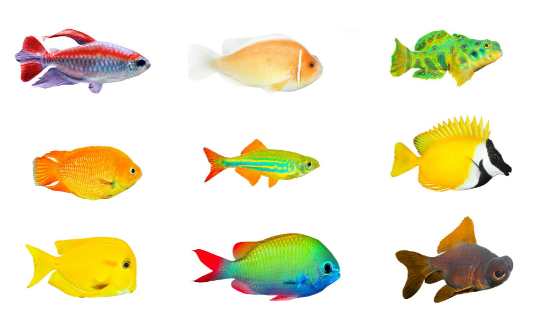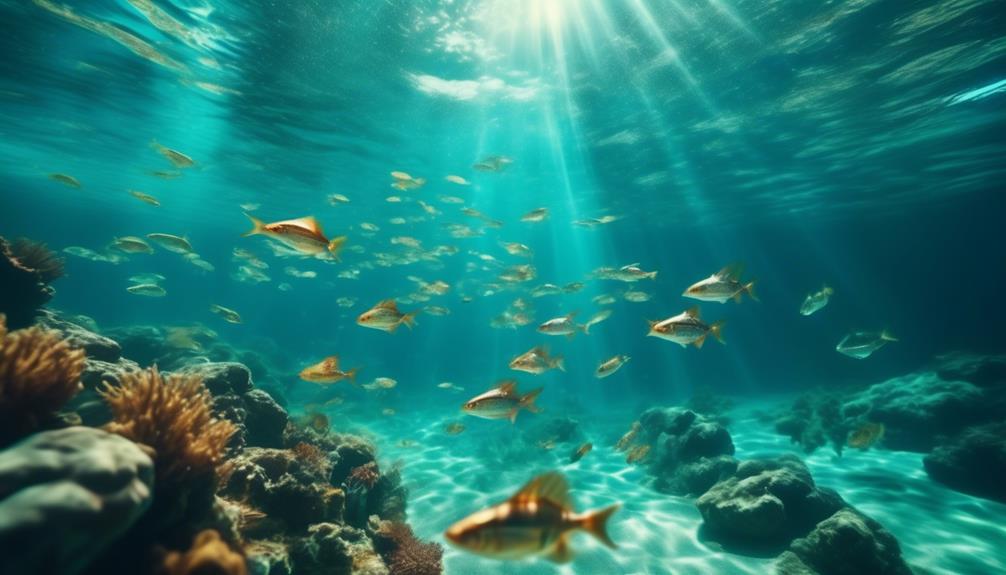
Step into the mesmerizing realm of ray fish, where the depths of the ocean hold secrets waiting to be unraveled.
Imagine gliding through the mysterious waters, surrounded by these enigmatic creatures that are more than meets the eye.
As you explore their captivating world, you'll uncover a wealth of knowledge about their distribution, physical characteristics, and care.
But that's not all – there's much more to discover, from their feeding habits to the fascinating array of ray fish varieties.
So, get ready to embark on an extraordinary journey, where each turn of the page will bring you closer to understanding the captivating world of ray fish.
Key Takeaways
- Ray fish are closely related to sharks and have unique characteristics such as disc-shaped bodies, wing-like pectoral fins, and venomous spines on their tails.
- They inhabit both marine and brackish water environments, and can be found in various parts of the world, including the Indian, Pacific, and Atlantic Oceans.
- Ray fish require large aquariums with open swimming spaces and soft sand substrate, and should be kept with large, non-aggressive fish due to their predatory nature.
- They have diverse feeding habits and accept a variety of live, frozen, and processed foods, with small portions fed multiple times a day to prevent overfeeding.
General Information About Ray Fish
Ray fish, closely related to sharks, are a fascinating group of fish that inhabit marine and brackish water environments. They're known for their large size, with some species reaching over 3 feet in length. These aggressive creatures require large aquariums, preferably 50+ gallons, to accommodate their needs.
They come in a variety of colors, including white, brown, grey, and black. When it comes to their care, they should be kept in large aquariums with open swimming spaces and soft sand substrate. It's important to note that they're predatory in nature and should only be kept with large, non-aggressive fish. Additionally, they've no sense of territory and may conflict with territorial tank mates.
In terms of feeding, most species of rays are omnivores and accept live, frozen, and processed foods. However, breeding ray fish in an aquarium is virtually impossible. So, if you're looking to add a fascinating and unique fish to your aquarium, consider the captivating world of ray fish.
Habitat and Distribution of Ray Fish
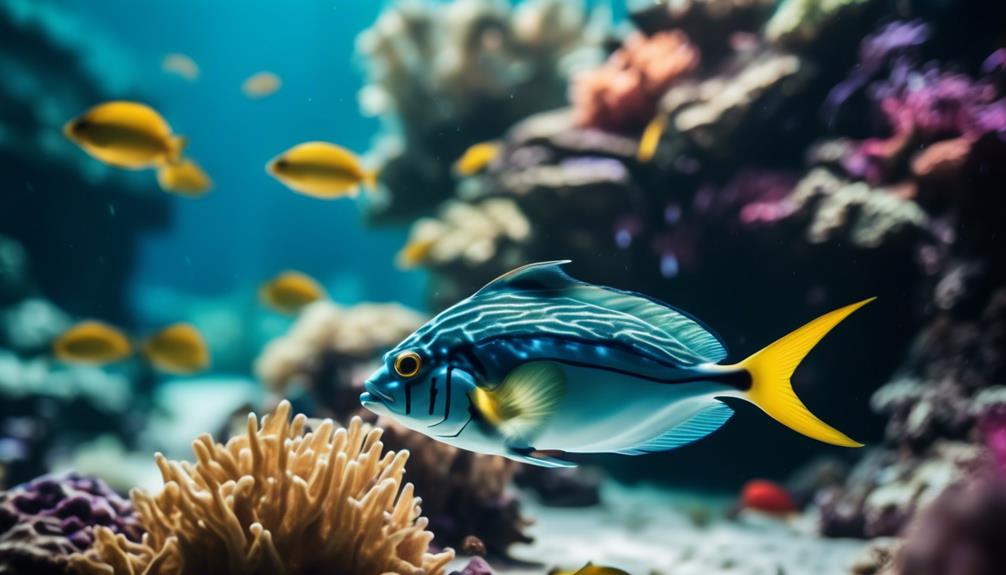
Rays, being closely related to sharks, can be found in various marine and brackish water environments around the world. They're widely distributed in the Indian, Pacific, and Atlantic Oceans.
Additionally, freshwater species of rays can be found in Asia, Africa, and North America. These fascinating creatures have adapted to thrive in diverse habitats, from coral reefs to estuaries and even freshwater rivers.
Their ability to inhabit both saltwater and freshwater environments is one of the factors that make them so unique. It's quite fascinating to think about the wide geographic range and diverse habitats in which these incredible creatures can be found.
Whether you're exploring the depths of the ocean or the calm waters of a river, rays have made their home in many different corners of the world.
Physical Characteristics of Ray Fish
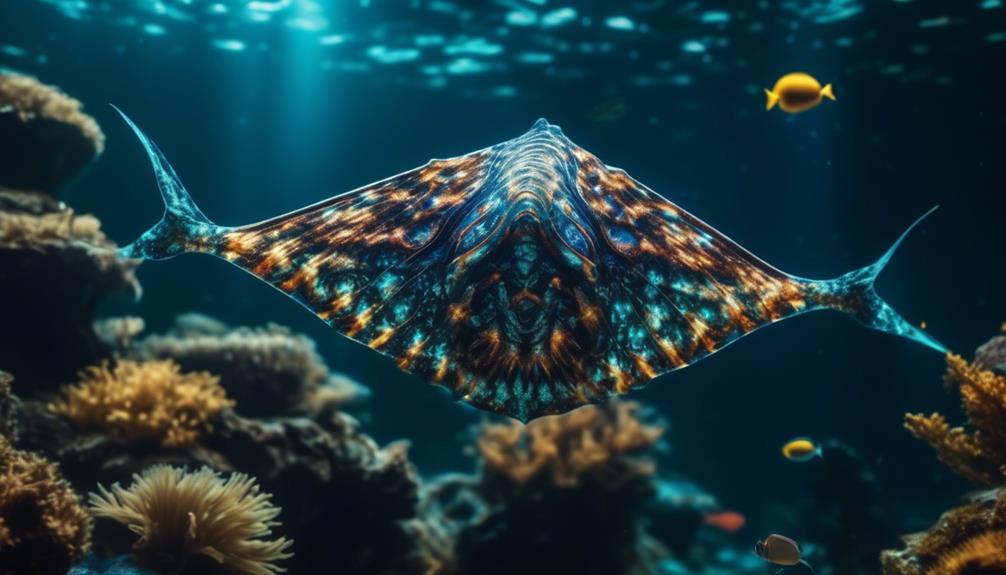
As we shift our focus to the physical characteristics of these remarkable creatures, you'll be intrigued by the unique traits that distinguish ray fish from other marine species.
Here are some key features that make ray fish so fascinating:
- Disc-shaped bodies: Ray fish have flat bodies that are shaped like discs, allowing them to effortlessly glide through the water.
- Wing-like pectoral fins: Their large, wing-like pectoral fins enable them to gracefully 'fly' through the ocean, giving them a majestic appearance.
- Spiked tails: Many ray fish have a long, whip-like tail that's armed with venomous spines, providing them with a defense mechanism against predators.
- Camouflaged skin: Ray fish have a specialized skin that can change color to blend in with their surroundings, allowing them to hide from potential threats.
These physical characteristics not only contribute to the beauty of ray fish, but also play a crucial role in their survival in their marine habitats.
Care and Tank Requirements for Ray Fish
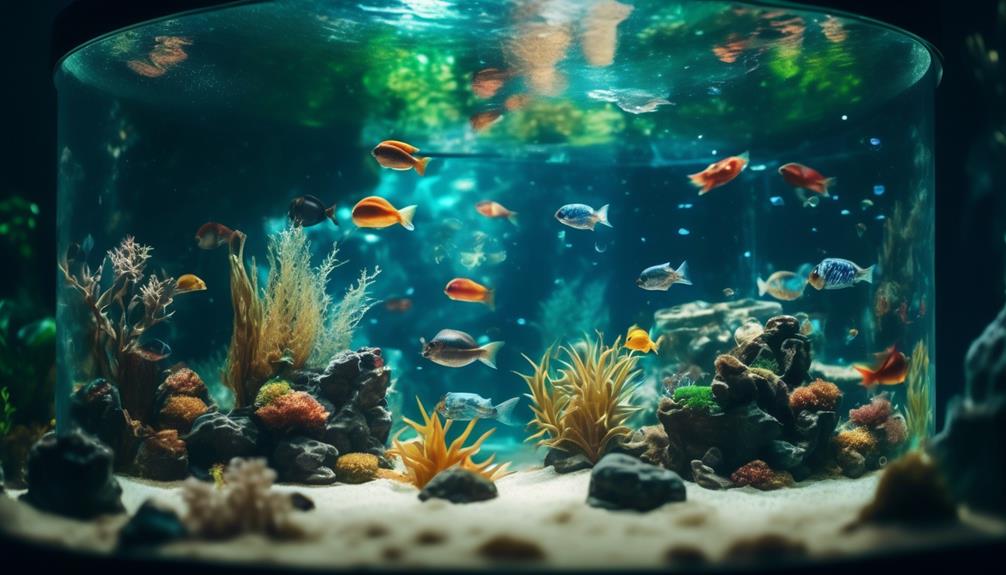
To properly care for ray fish in your aquarium, it's essential to meet their specific tank requirements.
Ray fish are large, aggressive creatures that require spacious tanks, preferably 50+ gallons. They should be kept in aquariums with open swimming spaces and soft sand substrate, as they like to bury themselves.
It's important to note that rays are predatory and should only be kept with large, non-aggressive fish. They've no sense of territory and may conflict with territorial tank mates.
When it comes to feeding, most species of rays are omnivores and accept live, frozen, and processed foods. However, breeding ray fish in an aquarium is virtually impossible.
Feeding Habits of Ray Fish
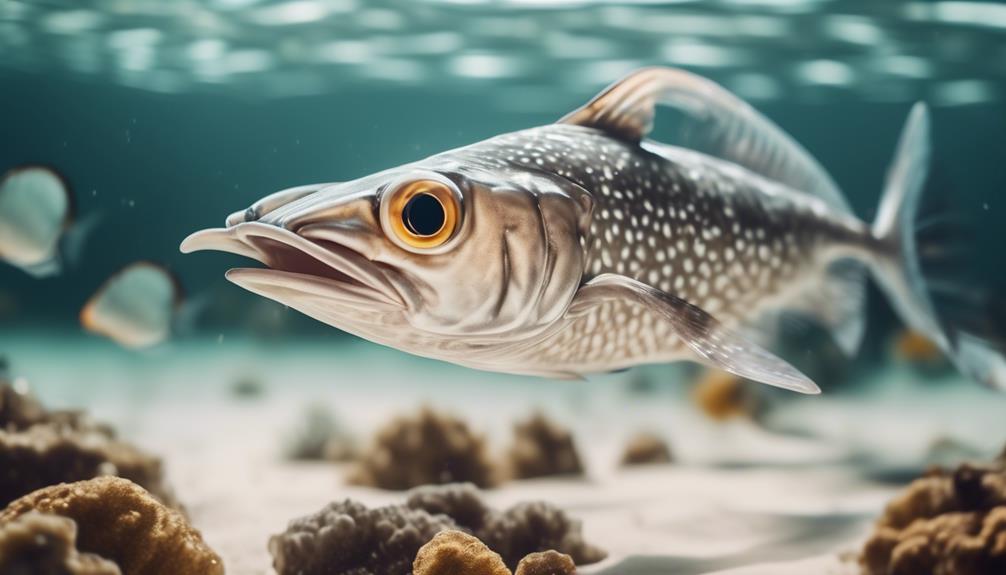
Feeding ray fish in an aquarium requires providing a balanced diet consisting of live, frozen, and processed foods to meet their omnivorous needs. To ensure their health and well-being, here are some important feeding habits to consider:
- Offer a variety of live foods such as small fish, shrimp, and worms to mimic their natural diet.
- Supplement their diet with frozen foods like brine shrimp, bloodworms, and krill to provide essential nutrients.
- Include processed foods specifically formulated for rays, such as pellets or flakes, to ensure they receive all the necessary vitamins and minerals.
- Remember to feed them small portions multiple times a day to prevent overfeeding and maintain water quality.
Breeding Challenges With Ray Fish

Breeding ray fish in an aquarium presents unique challenges that require careful consideration and preparation.
Unlike many other fish, breeding rays in captivity is extremely difficult. One of the main challenges is creating the right environment for successful reproduction. Rays require a large tank with plenty of open swimming space and soft sand substrate, which can be difficult to achieve in an aquarium setting.
Additionally, rays have specific breeding requirements that must be met, such as maintaining the right water temperature, salinity levels, and providing the appropriate diet. Another challenge is the aggressive nature of rays, which can lead to conflicts among potential breeding pairs.
Popular Species of Ray Fish in Aquariums
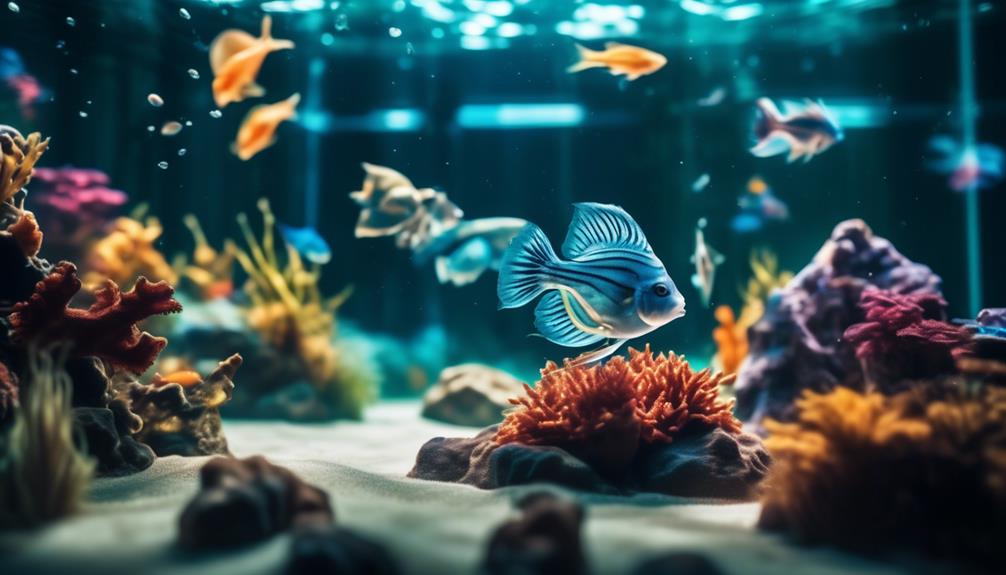
One popular species of ray fish commonly kept in aquariums is the Manta ray. These majestic creatures are known for their large size and graceful movements. They've a unique body structure with wide wings that allow them to glide through the water effortlessly. Manta rays are peaceful and can be kept with other non-aggressive fish. They require a large aquarium with plenty of space to swim and a soft sand substrate.
Here are some key facts about Manta rays:
- Manta rays are filter feeders, meaning they consume tiny organisms and plankton.
- They've a distinct pattern on their dorsal side, which helps with identification.
- Manta rays are intelligent and can recognize their caretakers.
- They've a lifespan of up to 50 years in captivity.
Keeping Manta rays in your aquarium can provide a unique and captivating experience.
Other Types of Ray Fish and Their Traits
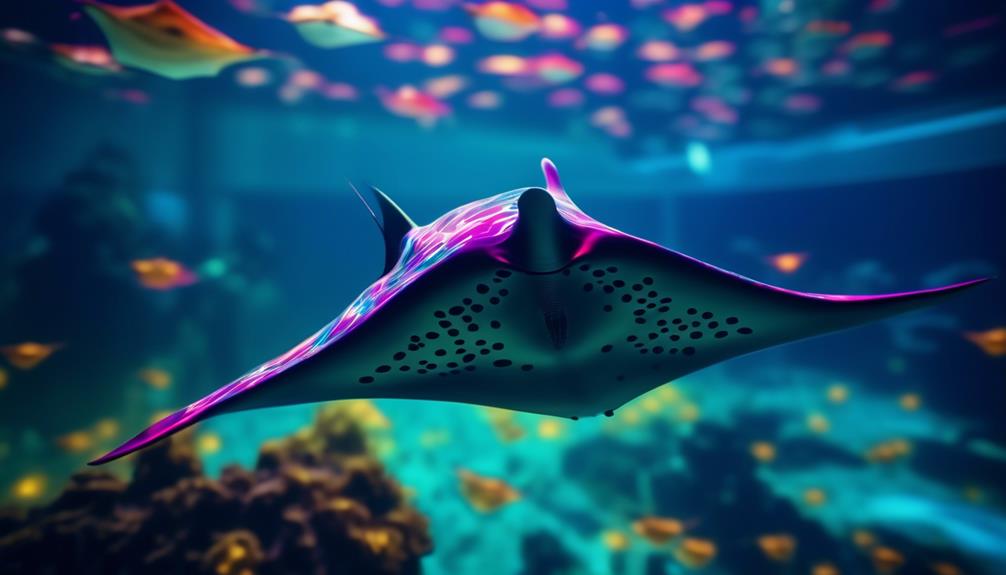
Now let's explore other fascinating types of ray fish and discover their unique traits.
In addition to the popular species mentioned earlier, there are several other intriguing varieties of ray fish.
One example is the Electric Ray, known for its ability to generate electric shocks to stun prey and deter predators.
Then, there's the Manta Ray, which is famous for its enormous size and graceful swimming. These gentle giants can reach up to 23 feet in wingspan, making them one of the largest ray fish in the world.
Another interesting type is the Stingray, recognized by its venomous barbed tail. Stingrays use their tails for self-defense, and their unique shape allows them to blend seamlessly into their surroundings.
Each type of ray fish has its own distinct characteristics and habitats, making them truly captivating creatures to observe.
Ray Fish in the Indian Ocean
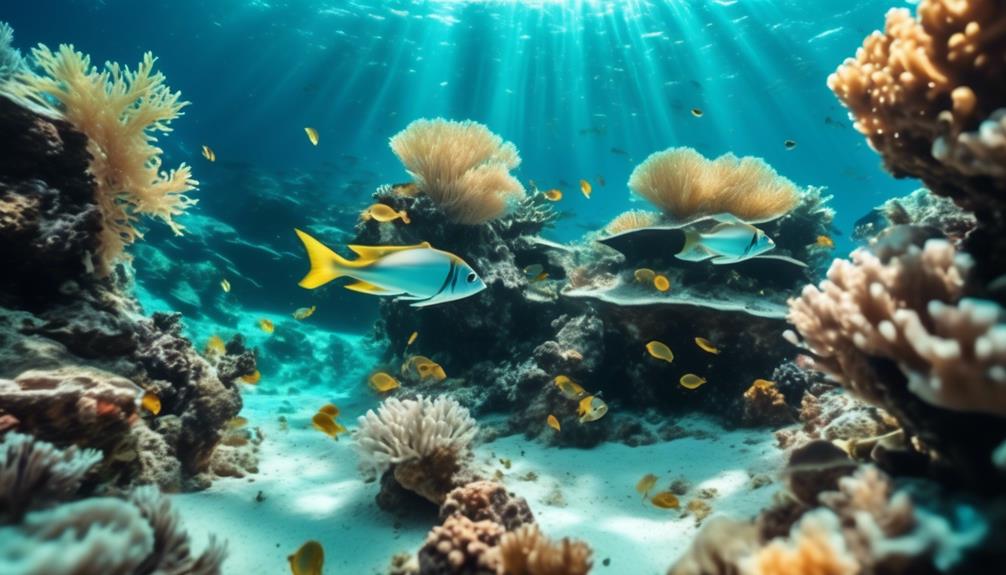
In the vast waters of the Indian Ocean, a multitude of ray fish species thrive with their unique adaptations and captivating beauty. These fascinating creatures have adapted to their environment in remarkable ways, allowing them to survive and thrive in the Indian Ocean.
Here are some key points about ray fish in this region:
- The Indian Ocean is home to a diverse range of ray fish species, including the majestic manta ray and the striking blue spotted ray.
- Rays in the Indian Ocean have adapted to the warm waters and sandy seabeds, making them well-suited to their habitat.
- Many ray species in the Indian Ocean have distinct markings and patterns on their bodies, making them visually stunning.
- Some ray species in the Indian Ocean have developed specialized feeding habits, such as the eagle ray, which feeds on small fish and crustaceans.
Exploring the rich diversity of ray fish in the Indian Ocean is a truly remarkable experience, showcasing the wonders of the underwater world.
Ray Fish in the Pacific Ocean
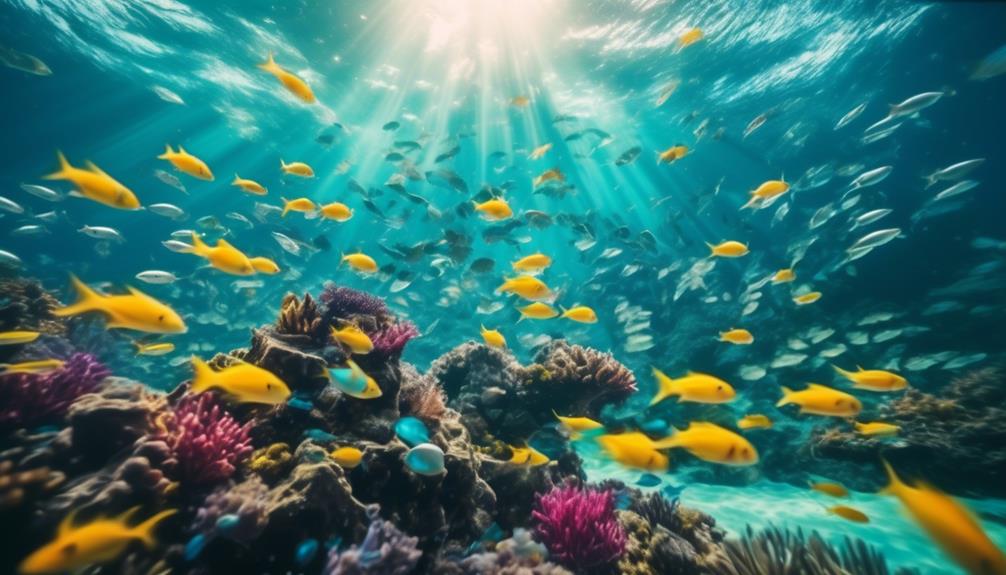
Ray fish thrive in the vast expanse of the Pacific Ocean, where their unique adaptations and captivating beauty are on full display.
The Pacific Ocean is home to a wide variety of ray species, each with its own distinct characteristics. One of the most well-known ray species in the Pacific Ocean is the manta ray, famous for its graceful movements and enormous size. These gentle giants can reach up to 23 feet in wingspan, making them one of the largest ray species in the world.
Another common sight in the Pacific Ocean is the stingray, known for its venomous barb located on its tail. These rays have adapted to their surroundings, blending seamlessly with the sandy ocean floor.
The Pacific Ocean provides the perfect environment for ray fish, allowing them to thrive and captivate all who encounter them.
Ray Fish in the Atlantic Ocean
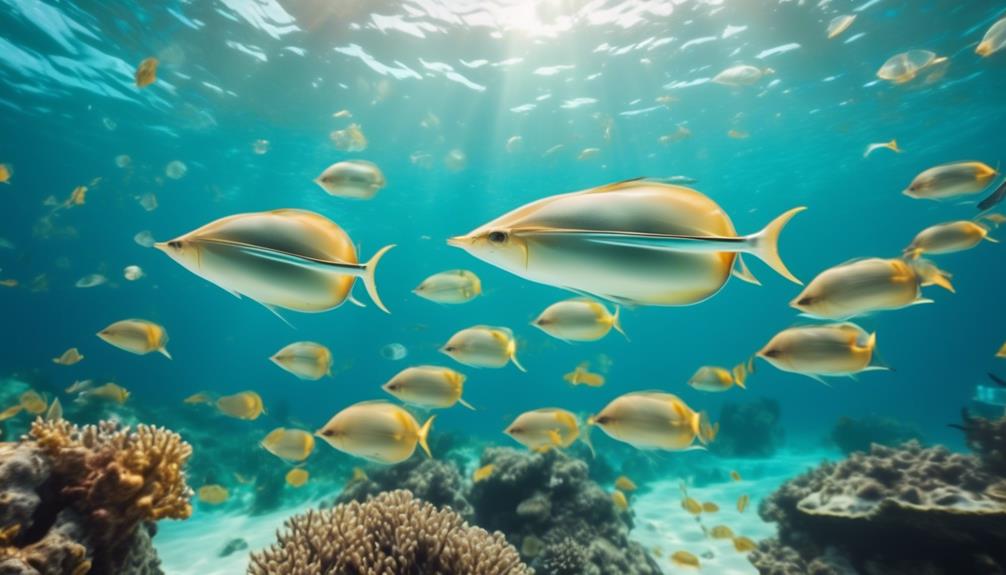
As we shift our focus to the Atlantic Ocean, let's explore the incredible world of ray fish in this vast marine environment.
- The Atlantic Ocean is home to a diverse range of ray fish species.
- From the majestic Manta Ray to the elusive Atlantic Stingray, these creatures captivate with their unique characteristics.
- Ray fish found in the Atlantic Ocean are known for their impressive size, with some growing up to 7 feet in wingspan.
- They thrive in various habitats, including coral reefs, sandy bottoms, and seagrass beds.
These fascinating creatures play a crucial role in maintaining the balance of the Atlantic Ocean ecosystem. With their graceful swimming movements and distinct appearance, encountering a ray fish in the Atlantic Ocean is an awe-inspiring experience.
Whether you're exploring the shallow coastal areas or venturing into the deeper waters, the Atlantic Ocean holds a treasure trove of ray fish waiting to be discovered.
Frequently Asked Questions
How Do Rays Defend Themselves Against Predators in the Wild?
In the wild, rays defend themselves against predators by using their strong, whip-like tails to deliver powerful blows. They also have venomous spines on their tails that can cause painful injuries to potential threats.
Can Rays Be Kept in a Freshwater Aquarium?
Yes, rays can be kept in a freshwater aquarium. They are found in freshwater environments in Asia, Africa, and North America. However, it is important to provide them with the right conditions and care.
Are There Any Specific Tank Mates That Are Known to Get Along Well With Rays?
There aren't any specific tank mates known to get along well with rays. It's best to keep them with large, non-aggressive fish. Remember, rays can be predatory and may conflict with territorial tank mates.
What Are Some Common Health Issues That Can Affect Ray Fish in Captivity?
Some common health issues that can affect ray fish in captivity include bacterial infections, parasitic infestations, and nutritional deficiencies. It's important to provide proper care, maintain water quality, and feed a balanced diet to prevent these problems.
Are There Any Specific Signs or Behaviors That Indicate a Ray Fish Is Stressed or Unhappy in Its Environment?
If a ray fish is stressed or unhappy, it may exhibit behaviors like hiding, not eating, or swimming erratically. Look for signs of aggression or physical changes. It's important to create a suitable environment to ensure their well-being.
What Makes Ray Fish so Fascinating and Enigmatic in the Saltwater Environment?
The exotic saltwater rays world is a fascinating place, and the enigmatic Ray fish is a major reason why. With their unique flattened bodies and wing-like fins, these creatures are masters of camouflage and can often be found buried in the sand, making them an intriguing sight in the ocean.
Conclusion
So there you have it, the fascinating world of ray fish! From their aggressive nature to their impressive size, rays are truly captivating creatures.
We've explored their distribution and origins, their physical characteristics, and how to care for them in aquariums. We've also learned about their feeding habits and the challenges of breeding them.
And let's not forget about the different varieties of rays, each with their own unique traits.
Now that you've uncovered the wonders of ray fish, take a dive into their captivating world and enjoy all they have to offer!




